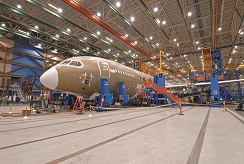
Selecting an appropriate location and managing an efficient supply chain from that location are critical for success. With careful analysis, suppliers can optimize their operations through successful supply chain management and location strategy.
Supply Chain Considerations
Building an aircraft is a massive undertaking. Nose to tail, millions of component parts, sourced from around the world, are required. Take the Boeing 787 Dreamliner. This aircraft has as many as 45 different large companies that supply its main components – not considering all of the minor components: switches, hardware, furnishings, finishes, electronics and so on. The total number of first-, second- and third-tier suppliers could be several thousand.
For defense programs, politics enters the picture as defense contractors endeavor to have key decision-making constituents participating as suppliers in the program. For commercial aircraft programs, major components are sourced globally to promote sales to airlines in countries around the world.
With so many suppliers for just one aerospace program, supply chain management is an ongoing juggling act.
Where are parts coming from? When will they arrive? Is there sufficient inventory to complete the next job? It would be difficult to determine how many individuals have a hand in manufacturing, purchasing and shipping all of these components. A large and diverse supply chain network and its corresponding issues are inevitable.
How Can Risk Be Managed?
Risk is inherent in the supply chain industry. The challenge is to ensure the risk is effectively managed. There are often items out of the supply chain team’s control, but with proper planning, a company can significantly reduce its exposure to the impact of a risk event.
Consider the recent labor standoff at West Coast ports that reduced the productivity of 29 ports to almost half. Produce shipments were completely lost and car parts were left stranded on ships for days, along with items intended for Chinese New Year celebrations.
Imagine that vital components for an aircraft project were sitting in a harbor for days. The lost production time for a supplier could be catastrophic.
Some American manufacturers are benefiting by making products in North America. This shortens their supply chain and reduces concern over longer lead times from foreign-made parts or port shutdowns; however, other concerns still exist: Can the supplier handle increased volume? What if a weather event disrupts the supplier’s plant? What if the supplier goes out of business? What if the truck carrier shipping a company’s vital components has an accident?
Not all risk can be removed, but it can be anticipated and mitigated with contingency plans.
The port slowdown was anticipated for over nine months. Logistics professionals took action to mitigate the impact of supplies being delayed, including building additional inventory of supplies, discussing possible alternate shipping routes and negotiating agreements with back-up suppliers.
Unexpected issues will arise. Planning ahead and mitigating risks will help a company continue to produce its products and meet the commitments it has made to customers.
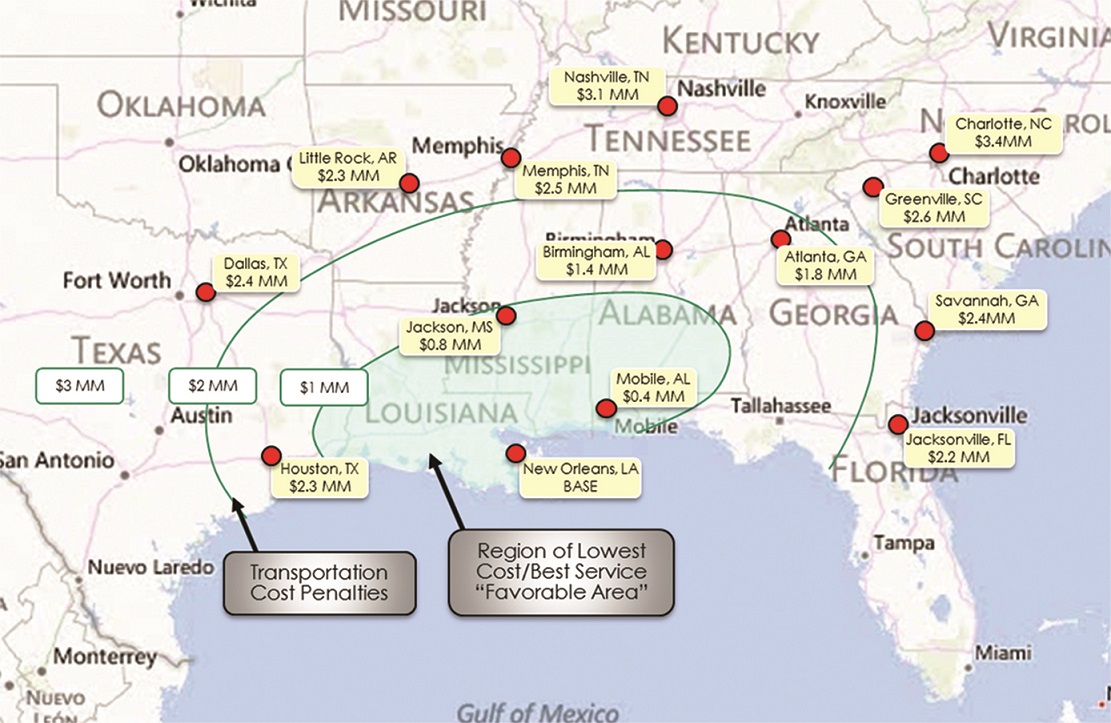
Can Supply Chain Predictability Be Achieved?
“Lean” supply chains are on the rise, but to realize the full opportunity they provide, there must be some predictability established in supply chain performance.
Every manufacturer dreads being out of a particular component to make its end product. Whether a result of a supplier or inventory management issue, it still is an issue that must be resolved.
“We are out of parts, now what do we do?” is a reactionary response. Lean supply chain management relies on integrated procurement and logistics management so that true partnerships are developed between supplies and their customers. There must be a relentless drive toward continuous improvement in the reliability of the lean supply chain, since removing risk and improving reliability improves everyone’s profitability. The strategy is to turn that reactionary response into future action through open dialog and exploration of options. What protections can be implemented to ensure that shortage doesn’t happen again? How can the supply chain team stay on top of these issues?
Establishing predictability may involve a complete overhaul of current processes. The company must move past, “This is how we’ve always done it,” to “How can this be done better?” Look at potential constraints that prevent knowing what the production schedule and inventory need to be. Workforce training may be needed, or perhaps a more efficient production schedule or better technology.
How Can Technology Help Manage Challenges?
The sky’s the limit! Many “off-the-shelf” products exist that help with inventory management, accounting and shipping. Custom solutions can also be created.
Technology can be a powerful tool and a software platform can be created to perform any number of tasks desired. A company needs to know what it wants. It is important to first review the entire supply chain and determine the most important factors for the business: inventory management, transportation management, supplier management, etc. Then, map out a technology solution that will help the business from start to finish. Once the concept is created, evaluate software solutions that can meet the company’s needs.
Data – the right data – is a formidable tool. Find a software system that supports the type of data needed for reports, early warnings to issues or other factors relevant to the business. Once the data is gathered, how it is used is fundamental. An experienced supply chain analyst should be able to access and work with all the numerous reports, KPIs and individual pieces of data available. When data can be mined and utilized, the company will experience the true power of technology and understand how powerful the company can be.
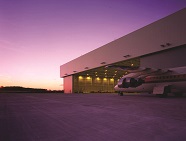 Beyond Supply Chain – Other Location Strategy Considerations
Beyond Supply Chain – Other Location Strategy Considerations
While supply chain considerations are critical with regard to location strategy for the aerospace industry, additional site location factors come into play when determining a new location.
Most business leaders understand the importance of labor, but sometimes give lesser weight to property and community considerations. There are important questions that should be analyzed and ranked for each candidate community before a final location is determined.
1. Labor
When considering the community or regional labor availability, the company must have a clear understanding of the types of workers and skill sets needed to operate the proposed facility. Understanding the labor situation for a candidate community far exceeds forecasting annual wage and fringe benefit costs. The company must consider the employment needs on day one, for the next five years and beyond to support anticipated future expansion.
Will key employees and their families from an existing operation be relocated? What percent of the workforce must be hired locally?
What training needs must be recruited? What compatible industries within the community or region are likely sources for employment?
How and where will the workforce be trained? Does the area technical school have a proven record for providing the necessary training? Consider hourly worker needs, as well as four-year universities with comprehensive engineering degrees and doctoral programs. What are the enrollment levels and graduation rates at the technical and four-year colleges and universities?
Often, communities successful in recruitment within the aerospace sector have historic ties to the aviation industry or contain a military base within the area. Retiring military personnel are often important and valuable resources as potential employees. If the candidate community is located within or close to an existing military base, consider:
What are the functions of the base?
What are current employment trends, such as civilian vs. technical military workforce?
Any concerns regarding base closures or downsizing at this location?
Where are retired ex-military employed locally? What skill sets do they have that are important to your operation? For example, an Air Force base will have a different skill base than an Army base, where infantry operations are the focus.
2. Property
Property considerations should be determined before the site location project initiates. These considerations must be intertwined with the company’s supply chain objectives, including:
Site size, with potential acres for expansion
Suitability of existing buildings
Access to major roadways and interstates
Rail availability, distance to commercial airports, deep water port access
Utility availability in sufficient quantities and preferred purchase price.
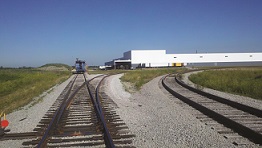 These and other considerations provide sufficient parameters to screen viable sites for field investigation. During field investigation, more unique considerations become important and different evaluation factors between each site will emerge. These factors will play a key role in rating and ranking the sites as the best location for the proposed facility.
These and other considerations provide sufficient parameters to screen viable sites for field investigation. During field investigation, more unique considerations become important and different evaluation factors between each site will emerge. These factors will play a key role in rating and ranking the sites as the best location for the proposed facility.
What is the projected image of the new facility: Basic manufacturing? Mostly administrative with office and research components? Company headquarters?
Is a site within an “upscale” industrial park or a “stand-alone” site in a heavy industrial zoned district the preferred location? Or something in between?
What is the preferred distance to amenities such as hotels, restaurants, shopping? Will the new facility have frequent visits by customers and vendors?
How dependent is the local airport on the company’s location decision: Does the site need to be on airport grounds? Is the company comfortable with a long-term lease from the airport authority? Are critical products being air-shipped on a daily basis?
3. Community
Many aerospace companies view a new location not only as a place to conduct business, but also as an extension of their company’s image. The aerospace industry may consider locations and communities with proven records of environmental sustainability and traditions of LEED® certified construction and those that understand smart building practices. A progressive, business-friendly community with a proven track record of community sustainability may be the best partner for the aerospace sector.
What type of footprint does the proposed facility wish to have in the selected community? Is a significant “up-front” or more low-key role more desirable?
What are the overall economic and demographic conditions of the area? Does the community contain a healthy mix of industrial and service sector employers or is it dominated by industries with little to no synergistic value to an aerospace operation?
If transferring workers from existing operations, in what type of community would workers and their families prefer to relocate?
With regard to incentives, consider:
How “business-friendly” has the community – and state – been to the aerospace industry, based on past projects?
Are there specific taxation policies that favor the aerospace industry? Could those be used for the proposed facility?
What type of “as-of-right” and discretionary packages do state and local governments typically offer? Do they include tax incentive programs for manufacturing, assembly and research and development?
Are major discretionary incentive programs available, such as cash grants and are they awarded based on employment levels, wage rates and investment numbers?
What are the consequences if the company fails to generate the proposed hiring and investment projections over a certain time?
Ultimately, aerospace suppliers want to select a location that not only enhances their supply chain efficiency, but that also fits their current and future needs with regard to labor, property and community. Understanding these requirements and analyzing associated risks will enable the supplier to optimize their location selection, allowing them to support their customers more efficiently.


